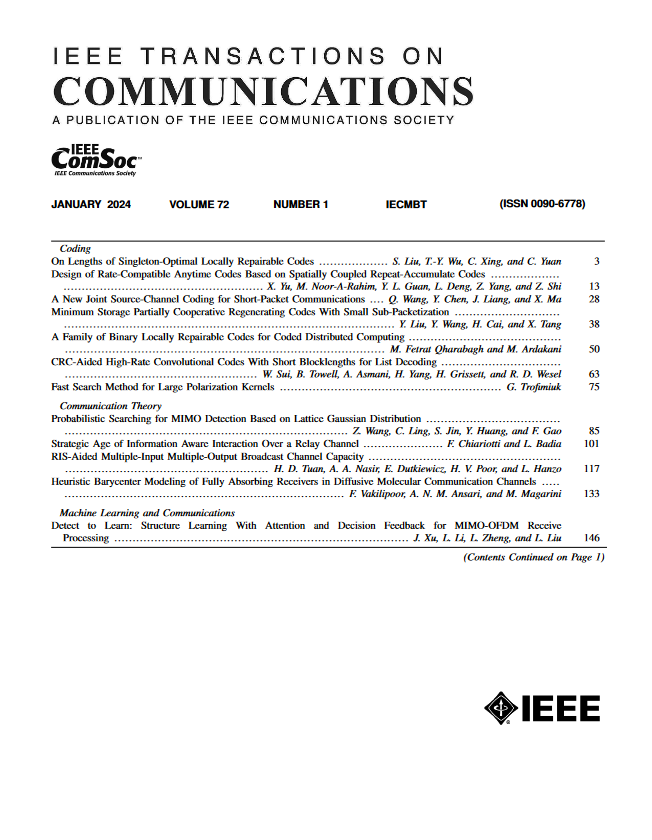面向低空经济的网络化ISAC:协调发射波束形成与无人机轨迹设计
IF 8.3
2区 计算机科学
Q1 ENGINEERING, ELECTRICAL & ELECTRONIC
引用次数: 0
摘要
本文利用网络化集成传感与通信(ISAC)技术支持低空经济(LAE),一组网络化地面基站(GBSs)协同传输联合信息和传感信号,与多架授权无人机(uav)通信,并同时在三维空间(3D)检测感兴趣区域上的未经授权的物体。我们假设每个GBS都配备均匀线性阵列(ULA)天线,这些天线要么水平部署,要么垂直部署到地面。我们还考虑了两种类型的无人机接收器,它们分别具有和不具有消除专用传感信号引起的干扰的能力。在每种设置下,结合授权无人机的轨迹控制及其GBS关联,共同设计多GBS协同发射波束形成,在保证传感要求的同时提高授权无人机的通信性能。特别是,我们的目标是在给定的飞行周期内最大化授权无人机的平均和速率,同时受到对感兴趣的3D传感区域的最小照明功率约束,单个gss的最大发射功率约束以及无人机的飞行约束。由于涉及到二进制UAV-GBS关联变量以及波束形成和轨迹变量的耦合,这些问题具有高度的非凸性和挑战性。为了解决这些非凸问题,我们提出了使用交替优化、连续凸逼近和半定松弛技术的有效算法。数值结果表明,所提出的联合协调发射波束形成和无人机轨迹设计有效地平衡了传感和通信性能的权衡,显著优于各种基准。研究还表明,水平放置的天线比垂直放置的天线具有更灵活的多波束设计,从而提高了性能,并且无人机接收机的感知干扰抵消能力有利于进一步提高ISAC性能。本文章由计算机程序翻译,如有差异,请以英文原文为准。
Networked ISAC for Low-Altitude Economy: Coordinated Transmit Beamforming and UAV Trajectory Design
This paper exploits the networked integrated sensing and communications (ISAC) to support low-altitude economy (LAE), in which a set of networked ground base stations (GBSs) cooperatively transmit joint information and sensing signals to communicate with multiple authorized uncrewed aerial vehicles (UAVs) and concurrently detect unauthorized objects over the interested region in the three-dimensional (3D) space. We assume that each GBS is equipped with uniform linear array (ULA) antennas, which are deployed either horizontally or vertically to the ground. We also consider two types of UAV receivers, which have and do not have the capability of canceling the interference caused by dedicated sensing signals, respectively. Under each setup, we jointly design the coordinated transmit beamforming at multiple GBSs together with the authorized UAVs’ trajectory control and their GBS associations, for enhancing the authorized UAVs’ communication performance while ensuring the sensing requirements. In particular, we aim to maximize the average sum rate of authorized UAVs over a given flight period, subject to the minimum illumination power constraints toward the interested 3D sensing region, the maximum transmit power constraints at individual GBSs, and the flight constraints of UAVs. These problems are highly non-convex and challenging to solve, due to the involvement of binary UAV-GBS association variables as well as the coupling of beamforming and trajectory variables. To solve these non-convex problems, we propose efficient algorithms by using the techniques of alternating optimization, successive convex approximation, and semi-definite relaxation. Numerical results show that the proposed joint coordinated transmit beamforming and UAV trajectory designs efficiently balance the sensing-communication performance tradeoffs and significantly outperform various benchmarks. It is also shown that the horizontally placed antennas lead to enhanced performance compared with their vertical counterparts due to the more flexible multi-beam design, and the sensing interference cancellation ability at UAV receivers is advantageous for further enhancing ISAC performance.
求助全文
通过发布文献求助,成功后即可免费获取论文全文。
去求助
来源期刊

IEEE Transactions on Communications
工程技术-电信学
CiteScore
16.10
自引率
8.40%
发文量
528
审稿时长
4.1 months
期刊介绍:
The IEEE Transactions on Communications is dedicated to publishing high-quality manuscripts that showcase advancements in the state-of-the-art of telecommunications. Our scope encompasses all aspects of telecommunications, including telephone, telegraphy, facsimile, and television, facilitated by electromagnetic propagation methods such as radio, wire, aerial, underground, coaxial, and submarine cables, as well as waveguides, communication satellites, and lasers. We cover telecommunications in various settings, including marine, aeronautical, space, and fixed station services, addressing topics such as repeaters, radio relaying, signal storage, regeneration, error detection and correction, multiplexing, carrier techniques, communication switching systems, data communications, and communication theory. Join us in advancing the field of telecommunications through groundbreaking research and innovation.
 求助内容:
求助内容: 应助结果提醒方式:
应助结果提醒方式:


